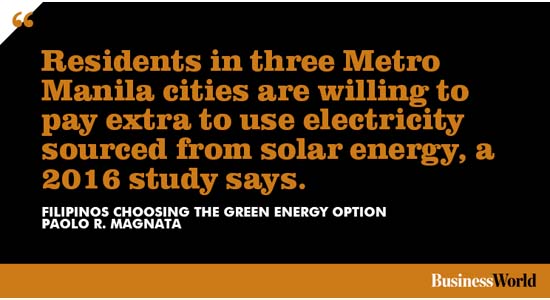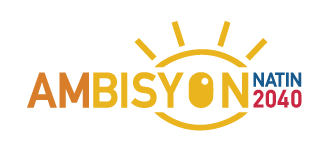Paolo R. Magnata (BusinessWorld)
THE ASEAN (Association of Southeast Asian Nations) is facing a new forefront and it’s the transition of energy dependence from fossil fuel generated electricity to sustainable and renewably generated electricity. The ASEAN has an aim of increasing renewable energy share in primary energy supply to at least 23% by 2025. The recently adopted Sustainable Development Goals (SDGs) has given more weight to ASEAN’s aim with SDG 7 for clean and affordable energy.

The Philippines is already at the forefront of the ASEAN region with 26% of its energy mix coming from renewable sources while the remaining 74% comes from a mix of coal, oil, natural gas, and other fossil fuels.
In 2015, the Department of Energy (DoE) took on a daunting task to at least raise the power generation mix of renewables to 30% by 2025. However, there shouldn’t be any solace even with the current developments as the country’s energy sector has maintained a heavy reliance on fossil fuels despite its connections to health and environment issues. Besides its effects on climate change and global warming, a Greenpeace study has cited that there have been 960 coal generated deaths every year with a potential of raising that number to 2,410 if the new power plants are to be developed.
Several policies have already been introduced and implemented to hasten the movement towards renewable energy while at the same time assist consumers and producers in tackling the high costs of electricity despite the increasing demand.
In 2008, the Renewable Energy Law was enacted by Congress in a bid to spur the development of renewable energy in the country. It had in its armory several incentive mechanisms that could provide financial feasibility for private sectors to invest in the development of renewables in the current energy mix. The most widely known mechanisms are the Feed-in-Tariff (FiT) — a premium rate paid for the generation of a particular type of electricity to encourage developers to invest in renewable energy — and the FiT Allowance — a mechanism used to further support renewable energy investment by uniformly charging consumers by kWh — however, these mechanisms have been blamed to increase electricity prices as they are an additional component in the electricity bill.
Despite its good intention to increase renewable energy investment, equally charging consumers a particular FiT Allowance and putting a premium on renewable energy financially burdens all consumers regardless of their willingness to pay for renewable energy development. This current system of pricing electricity tariffs can be changed by utilizing a different mechanism found in the Renewable Energy Law — the Green Energy Option. The Department of Energy defines this mechanism as a way of giving consumers the opportunity to determine where their electricity is sourced regardless if it’s purely solar, wind, geothermal, hydro, etc. But to ensure the use of this mechanism, there must be an existing demand from consumers to source their electricity from renewables and to utilize this mechanism.
To find out, in 2016, I conducted a study titled Choosing the Green Energy Option: A Willingness to Pay Study of Metro Manila Residents for Renewable Energy, which has also been recently presented in the WAVES National Conference in National Capital Accounting under Theme 2: Economic Valuation Studies for Natural Capital Accounting hosted by the National Economic Development Authority and World Bank last March 30-31, 2017.
The study used the contingent valuation method to determine if residential consumers were willing to pay for renewable energy and to estimate their respective willingness to pay. The study’s main query asked consumers located in Quezon City, Parañaque City, and Manila if they would be willing to participate a program where they would pay a premium of 30% of the electricity they use comes from Solar Energy. Afterwards, a dichotomous choice analysis yielded that Metro Manila residents were willing to pay P268 to P435 ($5.37 to $8.31) on top of their current electricity bill. This is approximately 0.97% to 1% of their monthly household income. It shows that Filipinos find a substantial value in utilizing solar energy instead of sustaining their current dependency on coal and fossil fuels. The demand for solar energy exists; however due to its minimal contribution in power generation mix, there is a failure in taking full advantage of this demand. Thus, the recommendation from this study is to make the Green Energy Option a functional mechanism for residential consumers and give them the opportunity to choose where the electricity they use in their homes comes from. The current reliance on the FiTs and FiT-Allowances reveals an equalized approach towards renewable energy and despite its noble goal to increase renewable investment it also results in high prices in electricity tariffs for all.
The Green Energy Option offers an alternative wherein we move from equally pricing all consumers (save for those with lifeline rates) to equitably charging consumers based on their willingness to pay for renewable energy. The move towards a greener and environmentally sustainable energy sector doesn’t have to be a costly burden to all consumers when we have the option to make it an equitable one.
